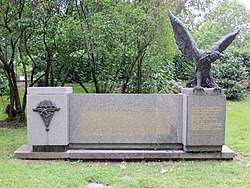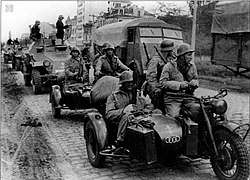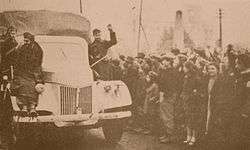Stratsin-Kumanovo operation
The Stratsin-Kumanovo operation[2] (Bulgarian: Страцинско-Кумановска операция) was an offensive operation of the Bulgarian Army in occupied Yugoslavia during the participation of Bulgaria in World War II against the Third Reich.

Development
Bulgarian military activity
It was held from 8 October to 14 November 1944 and was conducted in parallel with tree another Bulgarian offensive operations in Yugoslavia: the Niš operation; the Kosovo operation and the Bregalnitsa-Strumica operation. The operation was conducted in order to cross the road to retreat to a group of German armies "E" from Greece to central Europe. Bulgarian troops began an offensive on 8 October and the day entered into Kriva Palanka. Consistently they keep fighting for the Ridge of Stražin (October 18) and the Stracin position, that was seized on October 25. Support was provided also by the Bulgarian Air Force. The battles for Stražin were fierce, and the enemies were German paratroopers. Thus Stražin was captured with a Bulgarian paratroopers' attack.[3] However 35 of them were killed, and 64 were injured, that was 1/4 of the Parachute Druzhina. Battles continued on the river Pčinja and in the city of Kumanovo (11 November) where parts of the Wehrmacht were defeated again. The Bulgarians developed their advance towards Skopje into a large-scale offensive, which gave rise to the danger for Army Group E of being cut off. The situation was desperate and the town was evacuated urgently at the night of 13/14 November.[4] As result on 13 and 14 November parts of the First and Fourth Bulgarian Armies entered Skopje, which performed their task.[5][6][7][8] The onslaught continued as part of the Kosovo operation and on 19 November Bulgarian troops captured Pristina.[9]
Manipulation of historical events
In the autumn of 1944, the Bulgarian army was the real force behind the driving the Germans out of North Macedonia. The Macedonian Partisans there were not significant military force. They were ill-equipped and did not have good training.[10] However the official Yugoslav and later Macedonian historiography, has played down Bulgarian role by political grounds,[11] actually at the cost of historical deceptions. For example, because of the symbolic importance of the capital Skopje, according to Macedonian sources, Bulgarians did not participate in the operations for its capture, even as observers. Per Mihajlo Apostolski, Skopje was liberated by the Yugoslav partisans after several days of heavy fightings.[12] In relation with the nonsense written by him on that occasion, Apostolski became famous in Bulgaria with his phrase: "I have no evidence, but I claim it!"[13] Bulgarian sources maintain the first unit, which entered Skopje on November 13, was the cavalry intelligence platoon of the Second infantry division of the 4th Bulgarian army at 6.30pm. In fact the city was already left from the main German forces. Afterwards the Second infantry division of the First Bulgarian army took its southern and the eastern areas at 11pm. At the midnight the Bulgarians seized its center.[14] Because all the bridges and approaches to the city were blown up by the Germans, only infantry and cavalry units entered the city first.
Capture of Skopje
Skopje was seized with the decisive role of the Bulgarian troops.[15][16] In fact on a series of maps from Army Group E, showing its withdrawal through North Macedonia and Southern Serbia, as well as in the memoirs of its chief of staff, there is almost no indication of Yugoslav Partisan units, but only Bulgarian divisions.[17] Per the British commissioner in the Allied Commission in Sofia — General Walter Oxley, who personally visited the front line on Stracin, the task of the Bulgarian army was to advance in a westerly direction and to cut the railway line Skopje-Pristina-Kraljevo. He noted that the Bulgarians had been given complete freedom of action, and that there were no Soviet troops in the area of its offensive.[18] General Oxley reported that there were Yugoslav partisans in the area of the operations carried out by the Bulgarians, but because they were few, it was difficult for them to take any serious actions against the well organised German units.[19] Oxley was impressed by the discipline of the Bulgarian soldiers, but noted that this was a problem for the partisans.[20] He maintained also Skopje was seized after weak German resistance with Bulgarian Army concentric attacks, while the partisans stood waiting on the surrounding hills. They went just in time to support the Bulgarian entry into the city. The Bulgarians retained the POW-s, but they submitted the abandoned from the Germans weapons to the Tito's partisans.[21] The information that Skopje was captured by the Bulgarians was reported on November 14 and 15 by Radio Moscow, Radio London, the Voice of America, and Radio Sofia.[22]
Modern references
Nowadays, indicative in this respect is the 2016 Macedonian film The Liberation of Skopje, where compared with the Bulgarians, who move through the town like gangsters, the Nazis are gentlemen.[23] According to the Bulgarian Association for Research and Development of Civil Society, the movie, which is sponsored by the Macedonian government, is part of its propagandist agenda and breeds anti-Bulgarian hatred.[24] In October 2019 the Bulgarian government has set tough terms for North Macedonia’s EU candidature and part of them is both countries to "harmonize" their WWII historical narrative and that North Macedonia must overcome the hate speech against Bulgaria.[25]
Gallery
 Bulgarians re-entering occupied Yugoslavia.
Bulgarians re-entering occupied Yugoslavia. Bulgarian troops in Kriva Palanka.
Bulgarian troops in Kriva Palanka. Bulgarian Parachute Druzhina welcomed in Kumanovo.
Bulgarian Parachute Druzhina welcomed in Kumanovo. Bulgarians advancing toward the ridge of Strazhin.
Bulgarians advancing toward the ridge of Strazhin. Bulgarian fighters Messerschmitt Bf 109 in the autumn of 1944.
Bulgarian fighters Messerschmitt Bf 109 in the autumn of 1944. Captured by Bulgarian troops Germans soldiers near Kumanovo.
Captured by Bulgarian troops Germans soldiers near Kumanovo. Bulgarian troops entering Skopje on November 13.
Bulgarian troops entering Skopje on November 13. Bulgarian troops greeted as liberators in Skopje on 14 November.
Bulgarian troops greeted as liberators in Skopje on 14 November. Bulgarian troops welcomed in Skopje on November, 14.
Bulgarian troops welcomed in Skopje on November, 14. Bulgarian troops greeted by their return, Sofia, December.
Bulgarian troops greeted by their return, Sofia, December.
References
- Тодор Атанасовски, Тито ја сакал Македонија како држава;списание Глобус; 01.12.2009 г.
- Ivaylo Znepolski et al., Bulgaria under Communism Routledge Histories of Central and Eastern Europe, Routledge, 2018, ISBN 1351244892, chapter: Bulgaria in the shadow of Stalin, see also: Timeline of the People's Republic of Bulgaria.
- Андон Андонов, Димо Ангелев, История на военната авиация на България. Военно издателство, 1988, стр. 172.
- Karl Hnilicka: Das Ende auf dem Balkan 1944/45 – Die militärische Räumung Jugoslaviens durch die deutsche Wehrmacht, Musterschmidt, Göttingen 1970. (Studien und Dokumente zur Geschichte des Zweiten Weltkrieges, Band 13) ìn German; pp. 90-91; 95.
- Crawford, Steve. The Eastern Front Day by Day, 1941-45: A Photographic Chronology, Potomac Books, 2006, ISBN 1597970107, p. 170: "November 13, 1944: Greece, land war. The Bulgarian First Army ejects Army Group E from Skopje although, as most Axis forces have left Greece, this does not trap the army group."
- Stone & Ston; An online database of World War II, books and information on the Web since 1995: War Diary for Monday, 13 November 1944: German forces withdraw from Skopje as Bulgarian 1st Army advances. Bulgarian 1st Army captures Skopje. Southern flank of the Russian Front, 1944-1945; Balkan campaigns, the Aegean, and the Adriatic, 1942-1945.
- Alexander Perry Biddiscombe, The SS Hunter Battalions: The Hidden History of the Nazi Resistance Movement 1944-45, History Press Series, Tempus, 2006, ISBN 0752439383, p. 155. ..."By the late autumn of 1944, however, the Germans could no longer hold their base in Macedonia and they had to evacuate Skopje on 13 November, bringing covert operations against "Old Bulgaria" to a momentary hold."...
- Sfetas, Spyridon. "The Bulgarian-Yugoslav Dispute over the Macedonian Question as a Reflection of the Soviet-Yugoslav Controversy (1968-1980)". Balcanica. 2012. 241-271. 10.2298/BALC1243241S... "Indeed, the Soviets contributed heavily to Belgrade’s liberation in October 1944, and Bulgarians, though undesirable for the Yugoslav partisans, fought in the battles for the liberation Skopje in November 1944."
- Великите битки и борби на българите след освобождението, Световна библиотека, София, 2007, стр.73 – 74.
- Michael Palairet, Macedonia: A Voyage through History (Vol. 2), Cambridge Scholars Publishing, 2016, ISBN 1443888494, p. 212.
- Sfetas, Spyridon. (2012). The Bulgarian-Yugoslav dispute over the Macedonian question as a reflection of the Soviet-Yugoslav controversy (1968-1980). Balcanica. 2012. 241-271. 10.2298/BALC1243241S.
- Михаило Апостолски, Завршните операции на НОВ за ослободување на Македонија, „Кочо Рацин“, Скопје, 1953.
- Венко Марковски, "Кръвта вода не става", София, издателство на БАН, 1981 стр. 100.
- The first unit, which entered at 18.30 Skopje, already left from the Germans under the pressure of the Bulgarian army, was the intelligence cavalry platoon of the Second infantry division of the 4th Bulgarian army. For the liberation of Skopje contributed also detachments of the Second infantry division of the First Bulgarian Army. They forced the withdrawing Nazi detachments to retreat the city and on November 13th at 11pm took under their control the southern and the southeastern areas of the city. At the midnight they seized also its center. Georgi Daskalov, Bulgarian-Yugoslav political relations, 1944-1945, Kliment Ohridski University Press, 1989, p. 113; (in Bulgarian).
- Livanios, Dimitris, The Macedonian Question: Britain and the Southern Balkans 1939-1949, Oxford University Publishing, 2008, ISBN 0191528722, pp. 118-141.
- Karl Hnilicka: Das Ende auf dem Balkan 1944/45 – Die militärische Räumung Jugoslaviens durch die deutsche Wehrmacht, Musterschmidt, Göttingen 1970. (Studien und Dokumente zur Geschichte des Zweiten Weltkrieges, Band 13) ìn German; pp. 90-91; 95.
- War and revolution in Yugoslavia, 1941–1945: occupation and collaboration, Jozo Tomasevich, Stanford University Press, 2001, ISBN 0-8047-3615-4, pp. 751–752.
- Витка Тошкова, България-непризнатият противник на Третия райх, Военно издателство, 1995, стр. 146.
- Аврора Котева, Николай Котев, Британското разузнаване в България, 1939-1945; Издание 2, Военно издателство, 2003; ISBN 9545092661, стр. 168.
- Игнат Криворов, Военното изкуство на българската армия 1885-1945, Военно издателство, 2003; ISBN 954509270X, ст. 117.
- Georgi Daskalov, Bulgarian-Yugoslav political relations, 1944-1945, Kliment Ohridski University Press, 1989, p. 114; (in Bulgarian).
- Livanios, Dimitris, The Macedonian Question: Britain and the Southern Balkans 1939-1949, Oxford University Publishing, 2008, ISBN 0191528722, pp. 134-135.
- Sheri Linden, ‘The Liberation of Skopje’: Film Review; 12/6/2016 Hollywood reporter.
- Македония с нов филм против българската окупация (трейлър); OFFNews.bg 27.09.2016.
- Sinisa Jakov Marusic, Bulgaria Sets Tough Terms for North Macedonia’s EU Progress Skopje. BIRN; 10 October 2019.
